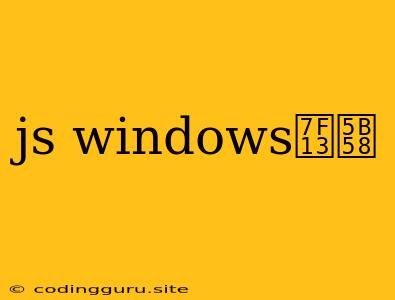Understanding and Managing JavaScript Windows Cache: A Comprehensive Guide
In the realm of web development, caching plays a crucial role in optimizing website performance and user experience. JavaScript (JS), being an integral part of modern web applications, heavily interacts with the browser's cache, leading to potential performance gains and challenges. This article delves into the intricacies of JS windows cache, explaining its mechanism, advantages, and how to effectively manage it.
What is JS Windows Cache?
The JS windows cache is a storage mechanism within a web browser that stores various resources, including JavaScript files, HTML documents, images, and CSS stylesheets, to speed up subsequent page loads. When a user visits a website, the browser downloads these resources and stores them in the cache. Upon revisiting the same site, the browser can retrieve the cached resources, eliminating the need for re-downloads, resulting in faster loading times.
Why Utilize JS Windows Cache?
Leveraging the JS windows cache offers several advantages:
- Faster page load times: By retrieving cached resources, the browser avoids redundant downloads, leading to significantly reduced page load times.
- Improved user experience: Users enjoy a smoother browsing experience with faster page loads, reducing frustration and increasing engagement.
- Reduced server load: By serving cached content, the server is relieved from handling repeated requests, enhancing its performance and scalability.
- Lower bandwidth consumption: Cached resources require less bandwidth, reducing data usage for users and optimizing network performance.
Types of JS Windows Cache
JS windows cache primarily functions through two mechanisms:
1. HTTP Cache: This type leverages HTTP headers to control caching behavior. The server sends specific directives in the response headers, instructing the browser on how to store and use cached resources. Common HTTP caching directives include:
- Cache-Control: This header specifies the cache's duration, validation mechanisms, and other caching-related instructions.
- Expires: Defines a specific date and time when the cached content should expire.
- Last-Modified: Indicates the last time the resource was modified on the server.
- ETag: A unique identifier for the resource, allowing the browser to verify its freshness.
2. Browser Cache: This mechanism is controlled by the browser itself, storing resources in a dedicated cache directory. The browser may use heuristics and algorithms to determine cache behavior, considering factors like file type, size, and expiration dates.
Managing JS Windows Cache for Optimal Performance
While JS windows cache is generally beneficial, it's essential to manage it effectively to prevent stale data and ensure optimal performance.
1. Expiry and Validation:
- Set appropriate expiry times: Use
Cache-ControlorExpiresheaders to define meaningful expiry times for your resources. A shorter expiry for frequently updated content and a longer one for static resources are recommended. - Utilize validation mechanisms: Implement
Last-ModifiedorETagto allow the browser to validate cached resources against server versions.
2. Cache Busting:
- Versioning: Include version numbers or unique identifiers in your resource filenames. When a file is updated, the version number changes, forcing the browser to download the new version.
- Query parameters: Append a query parameter to the resource URL, e.g.,
?v=12345. Updating the parameter value effectively invalidates the cache.
3. Conditional Get Requests:
- Use HTTP's
If-Modified-SinceandIf-None-Matchheaders to send conditional GET requests. The browser will only download the resource if it's been modified since the last request.
4. Browser Cache Control:
- Using localStorage: Store sensitive information or data that needs to be persistent in the user's browser.
- Using sessionStorage: Store information that needs to be available only for the current session, automatically expiring when the user closes the browser window.
5. JavaScript Cache Manipulation:
- Manually clearing the cache: Utilize JavaScript APIs like
sessionStorage.clear()orlocalStorage.clear()to clear the browser's cache for specific resources. - Using third-party libraries: Explore libraries like
cache-controlorcache-bustfor more advanced cache management and optimization.
Example of Cache Management with JS
// Set the cache control header for the script file
const scriptElement = document.createElement('script');
scriptElement.src = 'script.js';
scriptElement.setAttribute('cache-control', 'max-age=3600');
document.head.appendChild(scriptElement);
// Clear the browser's cache using localStorage
localStorage.clear();
Potential Challenges with JS Windows Cache
While JS windows cache is generally beneficial, there are a few potential challenges:
- Stale data: If resources expire too late, users may encounter outdated information.
- Cache invalidation issues: Improper cache busting or validation can lead to cached versions being served even when new versions are available.
- Security concerns: In some cases, caching sensitive information can pose security risks.
- Performance overhead: Frequent cache operations can add overhead and affect performance.
Best Practices for JS Windows Cache Management
- Understand your resource types: Differentiate between static and dynamic resources and set appropriate expiry times accordingly.
- Utilize browser development tools: Leverage browser developer tools to inspect cache settings, analyze performance, and identify cache-related issues.
- Test thoroughly: Thoroughly test your caching strategies across different browsers and devices to ensure optimal results.
- Monitor and analyze: Continuously monitor cache performance and make adjustments as needed to optimize caching behavior.
Conclusion
JS windows cache is an essential tool for optimizing web application performance. By understanding its mechanisms, advantages, and potential challenges, developers can effectively manage it for optimal performance and a seamless user experience. By implementing best practices, utilizing appropriate caching strategies, and consistently monitoring cache performance, you can ensure that your web application delivers a fast and efficient experience for your users.
